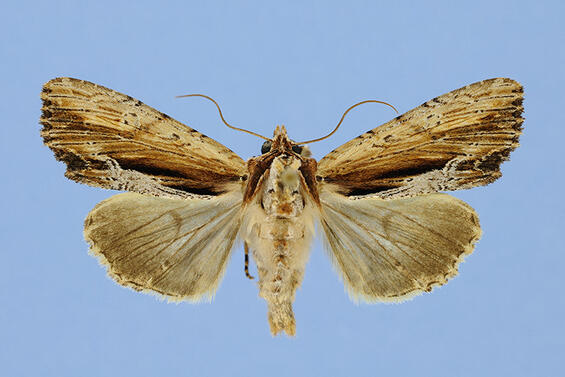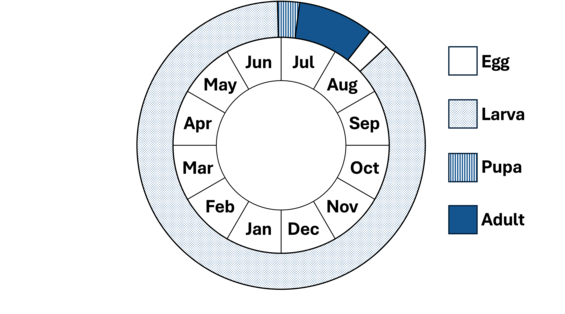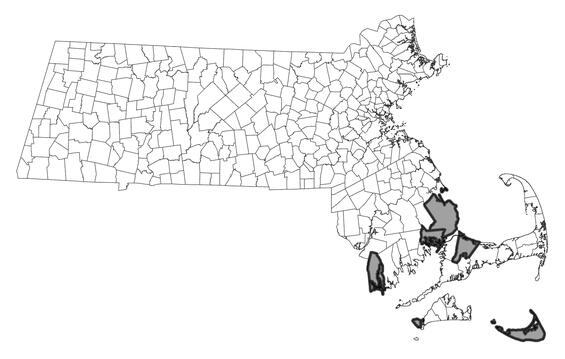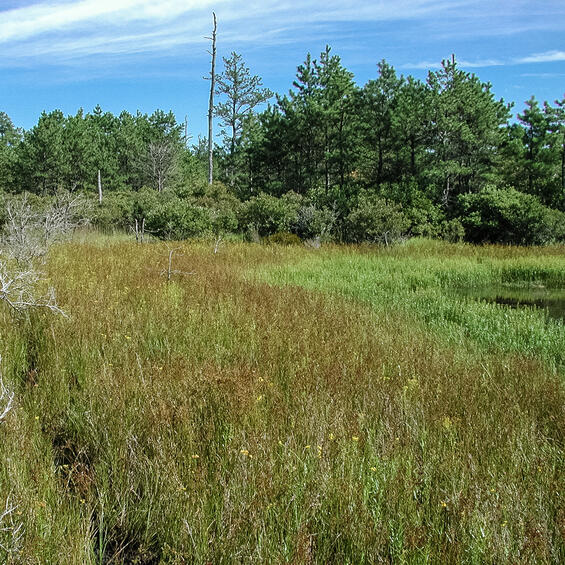- Scientific name: Apamea inebriata
- Species of Greatest Conservation Need (MA State Wildlife Action Plan)
- Special Concern (MA Endangered Species Act)
Description

Drunk apamea moth (Apamea inebriata)
The drunk apamea moth (Apamea inebriata) is a noctuid moth with a forewing length of 15-19 mm (0.6-0.8 in) (Ferguson 1977). The forewing is longitudinally streaked with straw yellow along the costal margin, reddish brown through the median area, black between the median area and the inner margin, and whitish gray along the inner margin, giving an overall appearance that is cryptic on dead wood (Mikkola et al. 2009). The reniform spot is faintly outlined with black and white dots. The hind wings are tan to brown, darker toward the wing margin, with a faint, elongate discal spot. Elongate scales on the head and thorax are a mixture of straw yellow, reddish brown, black, and whitish gray, matching the overall coloration of the forewing. The abdomen is tan with elongate, reddish brown and white scales dorsally. The drunk apamea moth was described and separated from the similar and more common and widespread wooden apamea moth (Apamea verbascoides) by Ferguson (1977). As compared to the wooden apamea, the drunk apamea is slightly smaller (forewing length about 1 mm/0.04 in shorter on average) and has a brighter appearance overall, with brown streaks that are more reddish, and the gray area along the inner margin more whitish and contrasting. The drunk apamea has a black basal dash that is shorter and thinner (sometimes almost completely absent) as compared to the wooden apamea. Additionally, the small white patch of scales at the juncture of wing veins M3 and Cu1 is more pronounced in the wooden apamea, much smaller or absent in the drunk apamea.
Life cycle and behavior

In Massachusetts, the drunk apamea moth flies in July and early August. Early instar larvae overwinter, and complete development in the spring. The larval host plants of the drunk apamea are undocumented but probably consist of one to several species of wetland grasses (Poaceae) or sedges (Cyperaceae).
Distribution and abundance
The drunk apamea moth is endemic to the coastal plain of eastern North America, from Nova Scotia south to North Carolina (Mikkola et al. 2009); it appears to be most common in New Jersey (Ferguson 1977). In Massachusetts, this species is largely restricted to coastal areas in the eastern part of the state.

Distribution in Massachusetts.
1999-2024
Based on records in the Natural Heritage Database.
Habitat
In Massachusetts, the drunk apamea moth inhabits fresh or brackish grass or sedge wetlands, including marshes, bogs, shrub swamps, and coastal plain pond shores.
Healthy habitats are vital for supporting native wildlife and plants. Explore habitats and learn about conservation and restoration in Massachusetts.

Coastal plain pond shore with grasses and sedges, habitat for the drunk apamea moth. Habitat managed by DCR at Myles Standish State Forest.
Threats
The drunk apamea moth is threatened by habitat loss and hydrologic alteration that disrupts the natural flooding of its habitat. Other potential threats include invasion by exotic plants, eutrophication or other water pollution, aerial insecticide spraying, non-target herbicide application, and off-road vehicles. This species is vulnerable to climate change, as some of its coastal wetland habitats are threatened by sea level rise.
Conservation
Land protection and habitat management are the primary conservation needs of the drunk apamea moth in Massachusetts. In particular, fresh or brackish grass or sedge wetlands, including marshes, bogs, shrub swamps, and coastal plain pond shores should be conserved, restored, and managed to maintain habitat for this species and other species dependent on such habitats.
Survey and monitoring
The distribution of the drunk apamea in Massachusetts is relatively well documented. Known populations of this species should be surveyed to document persistence at least once every 25 years; every 10 years is more desirable when practicable.
Management
Management of fresh or brackish grass or sedge wetlands benefits a suite of rare and threatened species. Restoration and maintenance of natural hydrology and control of invasive exotic plants are of primary importance. Habitat condition should be monitored and management adapted as needed.
Research needs
The natural history and conservation needs of the drunk apamea moth are only partially understood. In particular, its specific larval host plants are not known. The future effects of a warming climate on this species are unpredictable and should be documented.
References
Ferguson, D.C. 1977. A new North American species of Apamea formerly confused with A. verbascoides (Guenée) (Noctuidae). Journal of the Lepidopterists’ Society 31(1): 57-62.
Mikkola, K., J.D. Lafontaine, and J.D. Gill. 2009. Noctuoidea, Noctuidae (part): Xyleninae (part): Apameini (part): Apamea group of genera. Fascicle 26.9. 192 pp. in: Hodges, R.W. (ed.). The Moths of North America. Allen Press, Lawrence, Kansas.
Contact
| Date published: | March 21, 2025 |
|---|